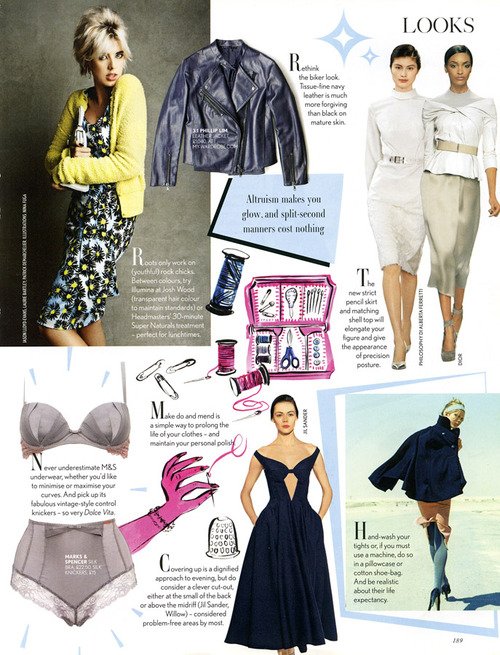Archive
- Behind the Screens 9
- Bright Young Things 16
- Colour Palette 64
- Dress Ups 60
- Fashionisms 25
- Fashionistamatics 107
- Foreign Exchange 13
- From the Pages of… 81
- G.U.I.L.T. 10
- Little Trifles 126
- Lost and Found 89
- Odd Socks 130
- Out of the Album 39
- Red Carpet 3
- Silver Screen Style 33
- Sit Like a Lady! 29
- Spin, Flip, Click 34
- Vintage Rescue 20
- Vintage Style 157
- Wardrobe 101 148
- What I Actually Wore 163
The Politics of Accessories and Elegance
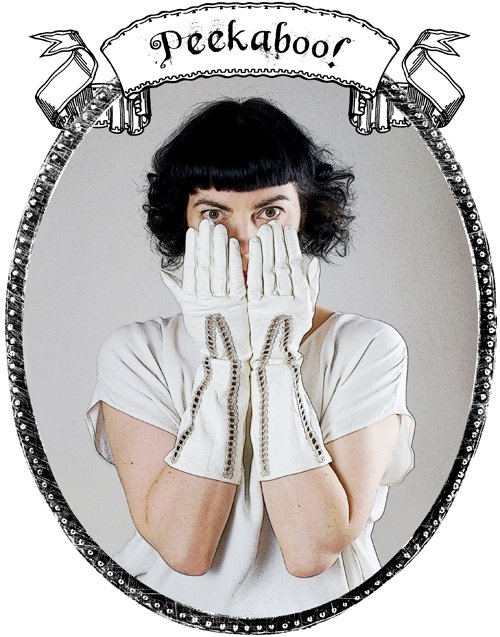 Time was that to be truly fashionable, a lady’s accessories all had to match, and the materials they were made from had to be appropriate for the occasion and time of day. Happily, we no longer live in such restrictive times, and today looking matchy-matchy is a horrible insult, a death knell to any pretentions to style.
Time was that to be truly fashionable, a lady’s accessories all had to match, and the materials they were made from had to be appropriate for the occasion and time of day. Happily, we no longer live in such restrictive times, and today looking matchy-matchy is a horrible insult, a death knell to any pretentions to style.
Looking backwards to the hey-dey of matchy-matchiness, the 1940s and 50s, I can do no better than to quote Genevieve Anotine Dariaux, French style guru, once derectrice at Nina Ricci, and author of the famous book A Guide to Elegance, first published in 1964:
‘The accessories worn with an outfit – gloves, hat, shoes, and handbag – are among the most important elements of an elegant appearance. A modest dress or suit can triple its face value when it is worn with an elegant hat, bag, gloves, and shoes, while a designer’s original can lose much of its prestige if its accessories have been carelessly selected.’
Quite the opposite is true today, when every fashionista rich or poor mixes new with vintage, high with low, with seemingly at times a particular delight in clashing as much as possible.
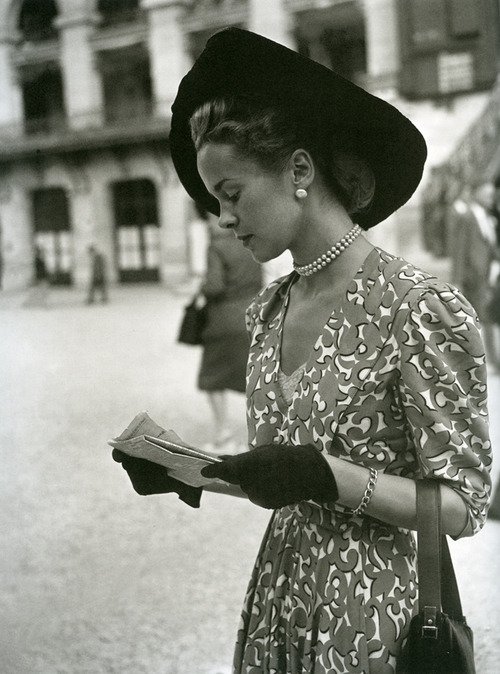 Elegant woman at Longchamp, Anonymous, 1947 (from ‘Parisiennes’, Flammarion 2007)
Elegant woman at Longchamp, Anonymous, 1947 (from ‘Parisiennes’, Flammarion 2007)
Seasonal Sets
Dariaux continues to elaborate on accessories, stating it is indispensable to own a complete set of accessories in black, and if possible, also brown plus beige shoes and a beige straw bag for summer. Ideally one would have every set suitable for sport, and the other dressy. Dariaux is filled with dismay when she sees a woman carrying an alligator handbag with a dressy ensemble, simply because she wishes to get good wear out of such an expensive item. (Has Dariaux not heard of the cost per wear equation?) ‘Alligator is strictly for sports or travel, shoes as well as bags, and this respected reptile should be permitted to retire every evening at 5pm.’
bright coloured shoes should only be worn under electric lights with a long or short evening dress
She has similar damning words for bright coloured shoes, which ‘should only be worn under electric lights with a long or short evening dress’.

All White is Not Alright
White shoes should never be seen on a city street – except for a tropical city, and even then only in summer, and only with a white dress. White handbags are impermissible except for the beach and summer resorts, but provincial in the city, even at the height of summer. Today fashion editors love to advocate white for winter, and I love it. Well truthfully, I love white anytime.
White handbags are impermissible except for the beach and summer resorts …
Gloves
But what does Dariaux say of gloves? They are best in neutral shades, and the most elegant of all are glacé kid. Suede and antelope are her second choices. Surprisingly, she gives good-quality thicker nylon gloves the thumbs-up.
She also believes gloves ought to be devoid of trimming, which I don’t at all agree with, while very long black gloves are the most elegant to wear with evening gowns. I own dozens of pairs in many colours and materials, even own a pair or two of crocheted lace and transparent nylon, which are both particularly despicable to Dariaux. Stylishly trimmed gloves I think are fun, and even an elegant woman can have fun sometimes!
 The entrance to the Paris Ritz on place Vendôme, Anonymous, c. 1948 (from ‘Parisiennes’, Flammarion 2007)
The entrance to the Paris Ritz on place Vendôme, Anonymous, c. 1948 (from ‘Parisiennes’, Flammarion 2007)
The Politics of Fashion and Elegance
Today of course most of us don’t wear any of our accessories in our day-to-day lives because they are ‘proper’ or traditional, but simply because we enjoy them. And of course the definition of elegance has changed slightly from Dariaux’s day when it was a stifling; it still means timeless chic in most lexicons, but there is a little more leeway for wit and daring, especially when it is employed with restraint.
In 1958, Claire McCardell, an American designer of the same era as Genevieve Dariaux, says:
‘Accessories are the signatures of your special tastes, clues to the type of woman you like being. Each is an idea in itself and you will quickly learn that you can’t wear too many ideas at the same time.’
This is permission to experiment a little more generous than that of Dariaux. The latter’s restrictive rules seem ludicrous to modern ears, but it wasn’t she who laid the law down: those fashion bills were passed with Christian Dior’s New Look in 1947, and the entire world imposed them on women who held any pretension to elegance, glamour – and worse than that: womanliness.
 Unpublished variant of a cover image for American Vogue, bu Erwen Blumenfeld, 1950
Unpublished variant of a cover image for American Vogue, bu Erwen Blumenfeld, 1950
Marnie Fogg, editor of Fashion: The Whole Story (Thames and Hudson, 2013) in the section ‘Daytime Decorum’ explains in a nutshell:
‘It was a perfect storm of events that resulted in the housewife of the 1950s becoming deified. Targeted by government policies, the fashion industry and advertisers, both she and her home were buffed, groomed and venerated. Liberated from the privations of wartime rationing, her clothing celebrated femininity with strict fashion discipline. A façade of perfection had to be upheld at all costs; to leave the house without a hat was little short of insurrection.’
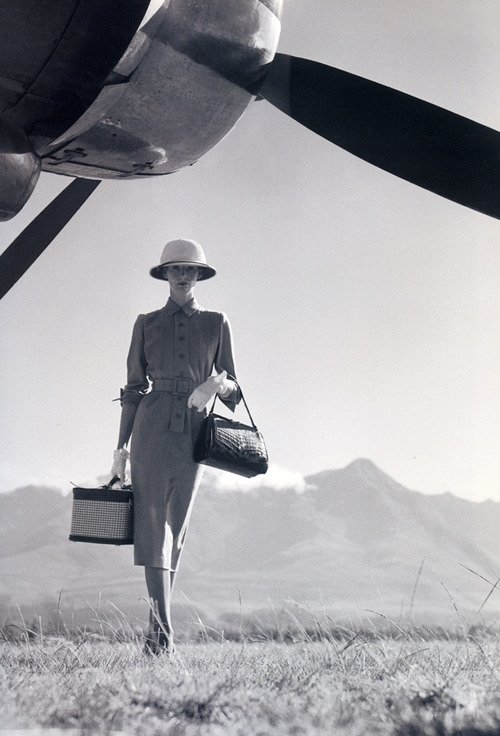 Alligator is correctly worn for travel or sport, according to Genevieve Dariaux. Wenda Rogerson, by Norman Parkinson, Vogue 1951Women’s liberation stalled after World War II, when American politicians advocated the return of women to their former role of homemakers so that homecoming servicemen would have jobs to return to. Instead, it was a woman’s job to be the perfect housewife. The social, moral and economic stability of the United States was entirely ‘dependent on men returning to their role as head of the household. Fashion played a significant role in this process by restoring the notion of traditional feminine clothing and making the business of dressing complex, with style diktats for every social and domestic function.’ [Ibid] It would take the next generation to change the world in the 1960s, when the fashion industry was turned on its head.
Alligator is correctly worn for travel or sport, according to Genevieve Dariaux. Wenda Rogerson, by Norman Parkinson, Vogue 1951Women’s liberation stalled after World War II, when American politicians advocated the return of women to their former role of homemakers so that homecoming servicemen would have jobs to return to. Instead, it was a woman’s job to be the perfect housewife. The social, moral and economic stability of the United States was entirely ‘dependent on men returning to their role as head of the household. Fashion played a significant role in this process by restoring the notion of traditional feminine clothing and making the business of dressing complex, with style diktats for every social and domestic function.’ [Ibid] It would take the next generation to change the world in the 1960s, when the fashion industry was turned on its head.

Matching v. Monochromatic
While I feel quite passé if my accessories match too well, I do think it fun to wear an entirely monochromatic outfit, especially all white. Black is my only exception for I find it dreary if it is not leavened with at least one other neutral. Kim Kardashian as we all know is very fond of wearing all beige, but I think it’s just because she likes that it makes her look naked.
Monochromatic outfits can be quite startling and eye-catching when one has become accustomed to the current popular trend for mismatching, which, with the encouragement of the fashion industry, many positively gorge on and glory in. Clash your prints! Mix and match! These are the clarion cries of this movement, and so often it is not done sympathetically. Wearing all one colour can in fact be soothing to the eye for just that reason.
I do not dispute that there were beautiful fashions in the post-war era, but today we have many more options than such rigorous and stifling rules and regulations. We can have fun, experiment – matchy-matchy or not according to personal preference – for even if we do commit some grave sartorial error we can take heart: the Fashion Police still can’t put us in jail for insurrection.
Photos: April 2016
The Gloves are On!
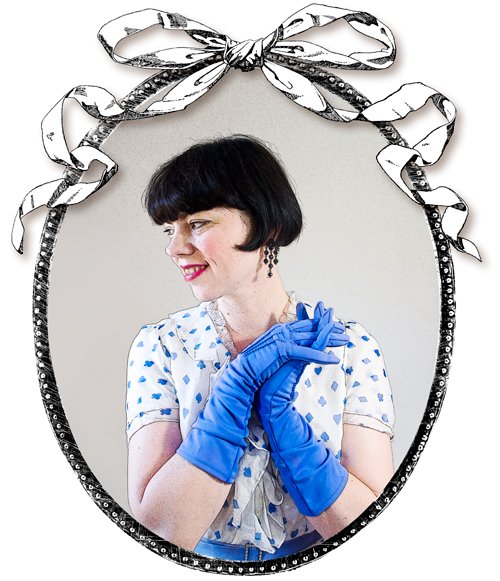 Vintage 60s periwinkle nylon gloves, worn with modern silk blouse Except in winter, or other special occasions, gloves have long since been a discarded accessory. Once upon a time, they were an indispensible component of a woman’s sartorial arsenal. And then decades ago, women became emancipated from fashion diktats, and the gloves – along with the hats and stockings – were joyfully tossed aside.
Vintage 60s periwinkle nylon gloves, worn with modern silk blouse Except in winter, or other special occasions, gloves have long since been a discarded accessory. Once upon a time, they were an indispensible component of a woman’s sartorial arsenal. And then decades ago, women became emancipated from fashion diktats, and the gloves – along with the hats and stockings – were joyfully tossed aside.
What a pity! All these additional accessories are one of the main reasons I welcome cooler weather: so many more opportunities to express oneself through fashion! Of course in summer there are still hats, and I’ve adopted the parasol too for pragmatic reasons, but in hot, sultry weather as we often have here in summer in my hometown of Melbourne, I am reluctant to load myself down with decorative accessories, such as scarves, or gloves.
Once upon a time, [gloves] were an indispensible component of a woman’s sartorial arsenal.
However, I really have no such excuse in spring, for this season is one of the most changeable in this climate. One day in the last month we literally went from morning sunshine, to noon thunderstorms and imminent hurricanes, and then less than half an hour later, the sun was gloriously shining again. In such a climate, it really is necessary to be prepared for anything, every day. So why not gloves?
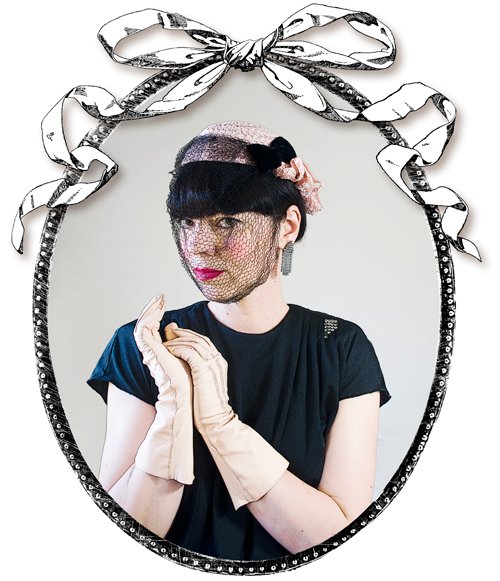 Vintage 1940s buff leather gloves, worn with 1940s hat and 1970s dressIt is difficult, I have discovered, to find new gloves that are anything more than pedestrian or basic in design. Colours, lengths, styles, trims – everything is extremely limited. Even in Spain and Portugal a few years ago I found nothing very unusual, and I visited a specialist glove store in Lisbon only to be bitterly disappointed.
Vintage 1940s buff leather gloves, worn with 1940s hat and 1970s dressIt is difficult, I have discovered, to find new gloves that are anything more than pedestrian or basic in design. Colours, lengths, styles, trims – everything is extremely limited. Even in Spain and Portugal a few years ago I found nothing very unusual, and I visited a specialist glove store in Lisbon only to be bitterly disappointed.
So I have turned to vintage gloves. I am lucky that I have quite small hands (about a size 7), so that I can find many that actually fit me. As Valerie Cummings, author of Gloves (B. T. Batsford, 1982) writes in her introduction: For several hundred years gloves were worn throughout the year, they were bought in dozens rather than pairs, and they came in a wide range of materials, colours, styles and sizes. This is why there are so many to choose from when purchasing vintage, although you’ll probably have more luck finding gloves that fit from the last five or six decades of the twentieth century.
I have amassed quite a large collection of really lovely vintage gloves; here are two pairs: buff kid leather 1940s French gloves – never worn – bought on Etsy, and a pair of periwinkle 1960s nylon gloves made in Hong Kong, purchased in a vintage bazaar in Geelong (a small city not far from Melbourne). Admittedly, I have not worn my collection as often as I should: just for fun, and at least occasionally. This must change – like the weather!
(Photo: March, 2014)
Brush Up On Style
 I thought this vintage clothes brush was so cute! However, I find the modern iterations more useful – a sticky lint roller is perfect for removing pet hair. Style is important. Good grooming is important. Looking your best is important. By this I do not mean keeping up with the very latest fashion trends – that can very often achieve quite the opposite effect!
I thought this vintage clothes brush was so cute! However, I find the modern iterations more useful – a sticky lint roller is perfect for removing pet hair. Style is important. Good grooming is important. Looking your best is important. By this I do not mean keeping up with the very latest fashion trends – that can very often achieve quite the opposite effect!
Some will consider fashion and attention to personal style frivolous, and meticulous grooming too much bother, adopting a defiant stance of, ‘you can take me or leave me’, or, ‘what does it matter as long as I’m comfortable?’
I believe however that looking your best does wonders for your morale on an everyday basis.
looking your best does wonders for your morale on an everyday basis
Your sense of style is a very personal thing. Sometimes it takes years to develop and it can change quite dramatically at different stages of your life. There are some principles that never change however, such as dressing to flatter your figure, and keeping your clothes and accessories neat and in good repair.
While my style over the last couple of decades has swung between the extremes of a vintage/retro look and a softer version of minimalism, here are some personal standards that have never changed:
Five Things That Make Me Feel Stylish
1. A good hairstyle
I unfailingly feel good about myself when my hair is looking good. I know as soon as it starts getting too long I start feeling distinctly dowdy. (Which is not to say I think long hair does not look chic on other people.) Whenever I go to the hair salon to have it cut short, I always exclaim, ‘Why on earth did I grow it long?!’ Right at the moment it’s grown out of the Klute-style shag, and I’m looking fondly at this short do above, from March 2014.
2. Striking lipstick
Bright lipstick is the biggest makeup statement I make. Regardless of what other makeup I am wearing, lipstick never fails to make me feel done. I tend to favour blue-toned pinks or strong reds.
3. Good quality garments that are well-taken care of
Hemlines that are falling down, missing buttons, holes in knits, split seams, ripped stockings, torn belt loops, clothes covered in pet hair, etcetera, are the antithesis of stylishness. I feel very self-conscious of some of these.
4. Unique accessories
I keep my eye out for unusual accessories, but I never wear too many at a time. I have a huge collection of amazing shoes and hats, but I also love belts, gloves and of course scarves, even if I don’t wear the latter two often.
5. Interesting proportions
I love unusual or avant-garde proportions, but if I’m going to wear something particularly outrageous, I keep the other elements low-key – less colour, less accessories – and let the silhouette do the talking.
Five Things That Make Me Feel Inelegant
1. Ill-fitting clothes
Not only are ill-fitting clothes uncomfortable physically, but they are also unflattering – which makes for mental discomfort. Sometimes that glimpse of myself in a window on the street can be a salutary lesson.
2. Badly-scuffed heels on shoes
I am absolutely ruthless about worn-out shoes. I will not wear them until they have been to the shoe repairer, and I have no compunction in throwing them in the trash when they are beyond help. I won’t donate such shoes to charity either – if I refuse to wear rubbishy shoes on the street, I’m not going to encourage someone else to do so!
3. Ripped jeans
This is a personal peeve. I know for many ripped jeans are the height of fashion, but as soon as even a favourite pair become ripped at the knee – out they go! I just hate it. I recently mourned a pair of Hudson jeans.
4. Fussiness
I don’t like too many things dangling about my person, or too many visual details. My colour palette has changed in the last year – I wear a lot more neutral clothes these days, usually with only one accent colour, or at most two, where the second is very minimal. Interest is in shape and texture.
5. Feet badly in need of a pedicure
I tend to have quite dry skin on my feet, so they require a lot of care to keep them looking good. If I am slack about it, my heels become very cracked – hideous in summer in particular! I’m so minimalist at the moment I’m even on a no-nail-polish kick! I kinda like the look of naked nails.
~
Have a read through these pages torn from British Vogue (although I can’t tell you which issue they are from unfortunately). They discuss both timeless details and trends current at the time of publication. (Click images for larger versions.)
Or if you’d like some advice on discovering your personal style, click here.
Dress-Ups
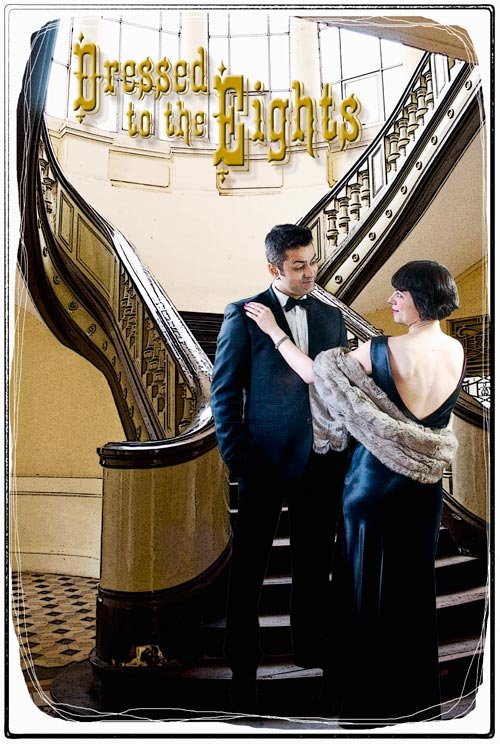 (Dressed to the nines includes a white tie)
(Dressed to the nines includes a white tie)
Once upon a time, people used to dress up to go out. Not just on a special occasion – every day was an occasion. There were particular outfits for all sorts of activities, whether a woman received her girlfriends wearing a teagown, wore a pretty pleated white tennis dress to run round the courts in, a smart suit and gloves for a trip to the city, or a dramatic floor length gown for a Saturday night at the theatre. Today you can go from morning to night in the same outfit, and so much glamour has gone out of our lives thereby. Life has become much less exciting.
I have a little theory – which I have not researched at all, but I like it: the cult of celebrity has reached such heights today, with people obsessively following their idols, precisely because their own lives are so dull. Normcore has been western culture’s downfall. People’s own sartorial adventures are virtually nonexistent that they must vicariously live through the wardrobes of the famous. They have nothing much in their own lives to look forward to, so they read about others’.
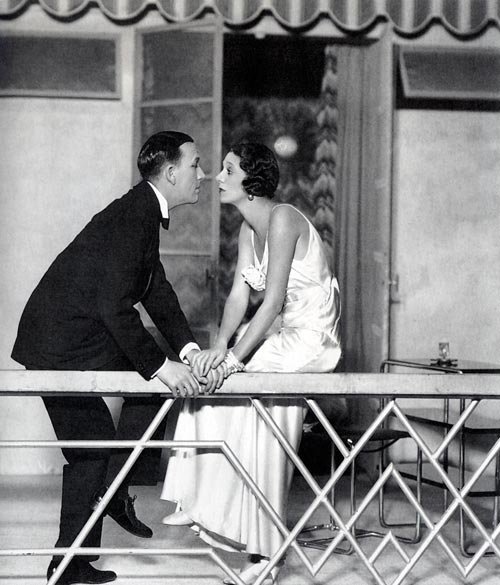 Noël Coward and Gertrude Lawrence in a scene from his play Private Lives, 1930Fashion magazines and bloggers report celebrities’ fashion follies and triumphs both, with a fanatical degree of attention to the minutiae of a star’s wardrobe. Look at the frenzied degree of interest provoked by the Duchess of Cambridge’s recent tour in the Antipodes. Fashion websites crashed, dresses sold out in minutes after photos of Kate were published online.
Noël Coward and Gertrude Lawrence in a scene from his play Private Lives, 1930Fashion magazines and bloggers report celebrities’ fashion follies and triumphs both, with a fanatical degree of attention to the minutiae of a star’s wardrobe. Look at the frenzied degree of interest provoked by the Duchess of Cambridge’s recent tour in the Antipodes. Fashion websites crashed, dresses sold out in minutes after photos of Kate were published online.
Of course not everyone is so dully clothed all the time, but certainly many Melburnians – especially in our cold winters – dress purely for practicality, and in a style that is hardcore normcore. One can venture into the city and be greeted by a sea of black, grey and navy blue.
 White moiré dress with terraced shoulders and train, by Maggy Rouff, 1930; illustration by Carl EricksonI work at a theatre, so I am lucky enough to regularly attend shows, and many opening nights. I have found it remarkable that even on opening nights many theatregoers dress casually, even in jeans. Where is their sense of occasion, their sense of fun? Part of the delight of an evening out is the anticipation prior: planning one’s outfit, getting ready in the hour(s) before. It’s what you look forward to at the end of the week.
White moiré dress with terraced shoulders and train, by Maggy Rouff, 1930; illustration by Carl EricksonI work at a theatre, so I am lucky enough to regularly attend shows, and many opening nights. I have found it remarkable that even on opening nights many theatregoers dress casually, even in jeans. Where is their sense of occasion, their sense of fun? Part of the delight of an evening out is the anticipation prior: planning one’s outfit, getting ready in the hour(s) before. It’s what you look forward to at the end of the week.
Earlier this year Volodya and I attended Melbourne Theatre Company’s opening night for Noël Coward’s Private Lives. Cocktail dress was stipulated for the evening, with an emphasis on the Art Deco style of the era the play is set in. My choice of gown was easy: a black satin crepe floor-length backless gown in a style very reminiscent of the 1930s, while Volodya wore a suit (though not the one in this picture). It was lovely to receive many compliments from both friends and strangers on the night. I was still surprised however to see a few attendees completely ignore the dress code and come in casual weekend wear.
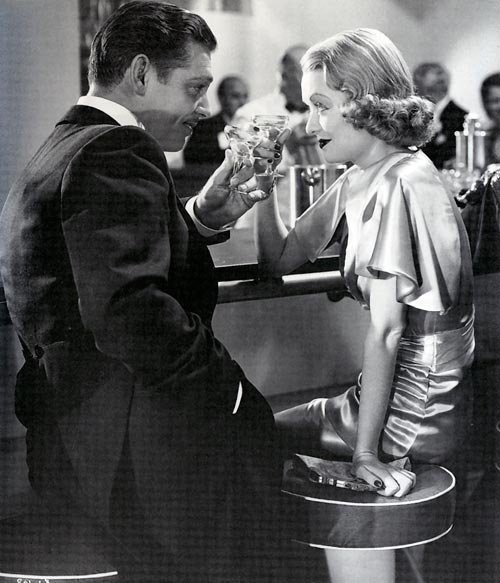 Clark Gable and Constance Bennett in After Office Hours, 1934Volodya and I had a few amusing wardrobe misadventures that made the beginning of the evening memorable: first the bottle of soda water I opened at home burst into a fountain all over the front of my dress breast to thigh; then Volodya discovered a button on jacket was hanging by a thread so that I had to resew it on; on the way to his car my favourite dainty black heels broke and I had to run back upstairs to find inferior replacements; and finally after we exited the car, I spotted a stubborn white mark on Volodya’s rear, which I had to remove with the aid of a bit of spit and a tissue. Fortunately we both have a sense of humour. It was like a sitcom, but only the prelude to a hilarious evening with lots of laughter.
Clark Gable and Constance Bennett in After Office Hours, 1934Volodya and I had a few amusing wardrobe misadventures that made the beginning of the evening memorable: first the bottle of soda water I opened at home burst into a fountain all over the front of my dress breast to thigh; then Volodya discovered a button on jacket was hanging by a thread so that I had to resew it on; on the way to his car my favourite dainty black heels broke and I had to run back upstairs to find inferior replacements; and finally after we exited the car, I spotted a stubborn white mark on Volodya’s rear, which I had to remove with the aid of a bit of spit and a tissue. Fortunately we both have a sense of humour. It was like a sitcom, but only the prelude to a hilarious evening with lots of laughter.
So go on, dress up – and live the movie of your own life.
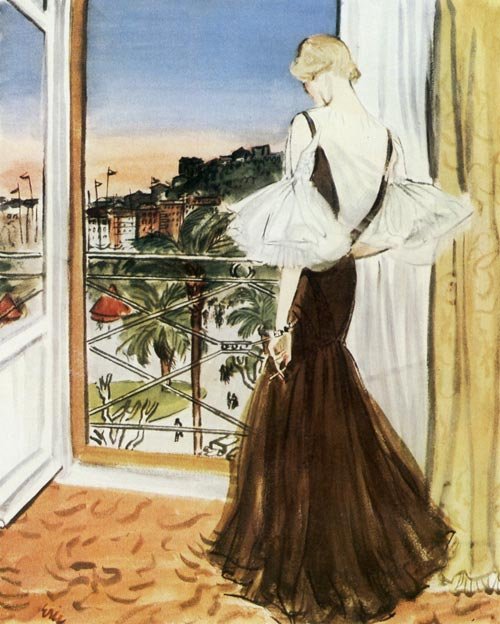 Coco Chanel’s 201 gown from 1933; illustration by Carl Erickson
Coco Chanel’s 201 gown from 1933; illustration by Carl Erickson
New Look, Old Rules
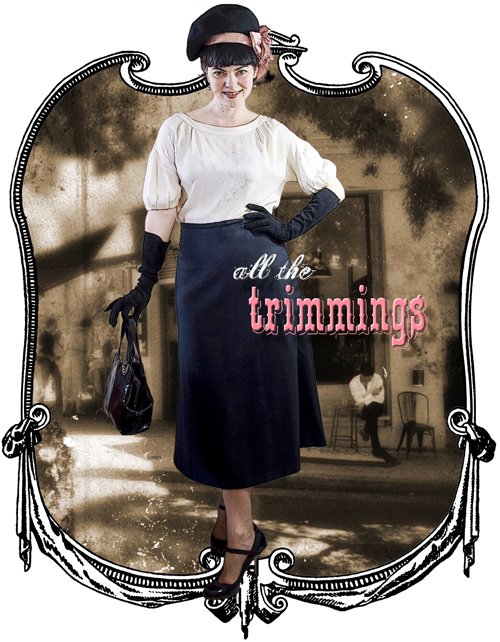 Reminiscent of the full-skirted New Look of the 40s: silk blouse by Veronika Maine, wool skirt by Sü, 40s hat and gloves, 60s bag, stockings by Levante, shoes by BCBGOh how times have changed, and thank goodness for that! Though there is much to love about vintage fashion and style, I am so happy that the all-pervading enslavement to fashion rules and regulations that once held sway over women has been laid to rest.
Reminiscent of the full-skirted New Look of the 40s: silk blouse by Veronika Maine, wool skirt by Sü, 40s hat and gloves, 60s bag, stockings by Levante, shoes by BCBGOh how times have changed, and thank goodness for that! Though there is much to love about vintage fashion and style, I am so happy that the all-pervading enslavement to fashion rules and regulations that once held sway over women has been laid to rest.
Once, an elegant woman could not venture upon the street without her matching hat, gloves, shoes and bag. Moreover, there were separate sets for town and country, for sporting kit and dressy ensembles. These sets were comprised of all black items, (in addition, if possible, a set all in brown) and beige shoes with a straw handbag for summer.
In A Guide to Elegance (Harper Collins, 2003 ed.), Genevieve Antoine Dariaux opens the section on accessories with: ‘The accessories worn with an outfit – gloves, hat, shoes, and handbag – are among the most important elements of an elegant appearance. A modest dress or suit can triple its face value when it is worn with an elegant hat, bag, gloves and shoes, while a designer’s original can lose much of its prestige if its accessories have been carelessly selected.’
 This sounds fine … at first glance. But read on and learn, for instance, that alligator was only worn with casual outfits (it would be vulgar and nouveau riche to carry an expensive alligator bag with dressy clothes); trousers should never be worn with a heel, rather ballerinas or moccasins; and coloured shoes were suitable with evening dresses and nothing else, while white were worn only in summer with a white dress (and never in the city, except in the tropics). Preferably, gloves should be glacé kidskin, followed by suede and antelope (which need to be replaced often to remain fresh), and good quality nylon. Crocheted lace or transparent nylon gloves were an abomination. As for novelty handbags: Out.
This sounds fine … at first glance. But read on and learn, for instance, that alligator was only worn with casual outfits (it would be vulgar and nouveau riche to carry an expensive alligator bag with dressy clothes); trousers should never be worn with a heel, rather ballerinas or moccasins; and coloured shoes were suitable with evening dresses and nothing else, while white were worn only in summer with a white dress (and never in the city, except in the tropics). Preferably, gloves should be glacé kidskin, followed by suede and antelope (which need to be replaced often to remain fresh), and good quality nylon. Crocheted lace or transparent nylon gloves were an abomination. As for novelty handbags: Out.
These are the shoes Dariaux lists as having no place in the elegant woman’s wardrobe:
- too high heels (vulgar – 2.5 inches max);
- open-toed shoes (toes might get stepped on, or wet in the rain);
- wedge heels (awkward, with transparent heels being in particularly bad taste);
- ankle straps (unflattering and cheap-looking);
- extra pointy-toed shoes (the empty toes curl skywards with wear);
- and all other kinds of shoes that attract too much attention (they attract too much attention).
She decrees: ‘Shoes should be the complement of an ensemble, never an end to themselves.’
How thankful I am we are freed from this kind of sartorial tyranny today …
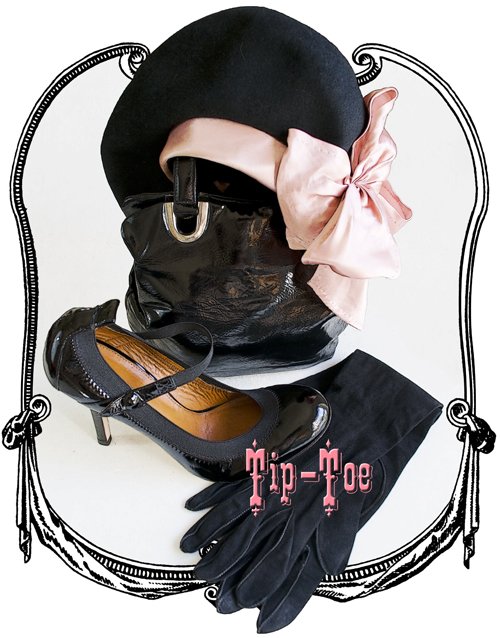 A (mostly) proper all black set: vintage 40s wool felt hat and suede gloves, vintage 60s vinyl bag, patent Mary-Jane shoes by BCBG (new)Oh dear. While I don’t know her view on millinery (the chapter is mysteriously omitted from the re-edition of her book), I fail on every other count. A Guide to Elegance was first published in 1964, the era of the Youthquake and the mini, which I find surprising – perhaps it was Dariaux’s response to all the shocking sartorial vulgarities and blunders she saw around her. Though her book does contain many gems still applicable today, and it is an entertaining read, she must have seemed fossilised even then.
A (mostly) proper all black set: vintage 40s wool felt hat and suede gloves, vintage 60s vinyl bag, patent Mary-Jane shoes by BCBG (new)Oh dear. While I don’t know her view on millinery (the chapter is mysteriously omitted from the re-edition of her book), I fail on every other count. A Guide to Elegance was first published in 1964, the era of the Youthquake and the mini, which I find surprising – perhaps it was Dariaux’s response to all the shocking sartorial vulgarities and blunders she saw around her. Though her book does contain many gems still applicable today, and it is an entertaining read, she must have seemed fossilised even then.
How thankful I am we are freed from this kind of sartorial tyranny today – we are able to express our personality and choose our accessories a little more lightheartedly. Life’s too short to take fashion so seriously. Vive la liberté!




